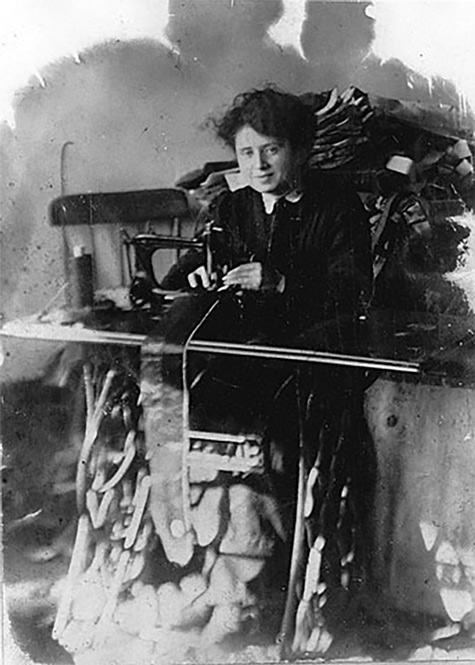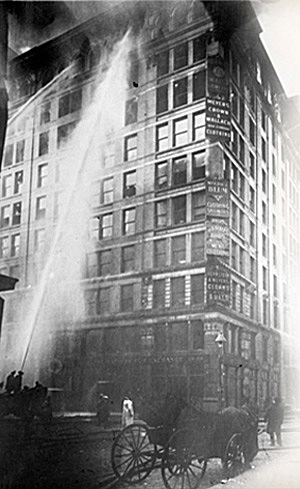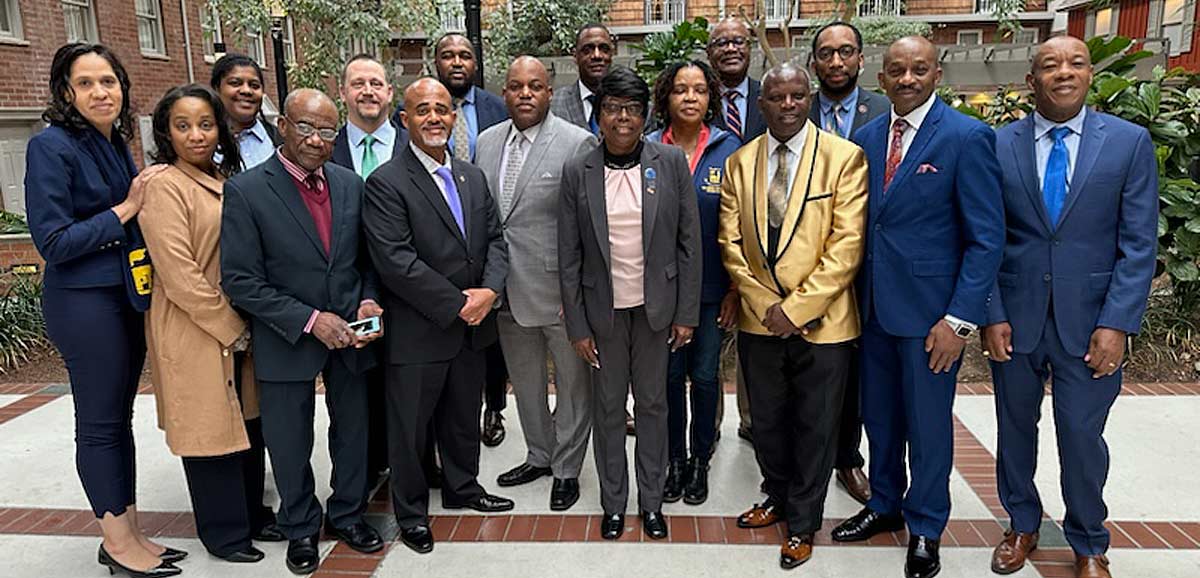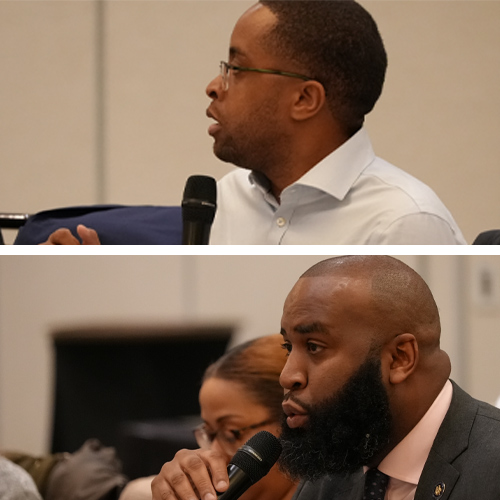The following statement was released to the media by PEF President Wayne Spence on March 26 following the shooting death of NYPD Officer Jonathan Diller on March 25 in Queens. (Read The New York Times’ story, here.)
Triangle Shirtwaist factory fire forever a part of American labor history

March 25 marks the 113th anniversary of one of the deadliest industrial disasters in American history. On this day in 1911, 146 garment workers lost their lives in a massive fire at the factory where they worked for the Triangle Shirtwaist Company.
The factory produced women’s blouses and was owned by Max Blanck and Isaac Harris. There were about 500 workers employed there, mostly immigrant women and girls as young as 14-years-old. These workers earned as low as $7 a week, with some paid up to $15 a week; that’s roughly $215-460 a week in today’s dollars.
The doors and exits to the factory were commonly locked to prevent workers from taking unauthorized breaks and reduce theft. On the day of the fire, many workers jumped from the 10th floor windows in an attempt to save themselves. It only took 18 minutes for firefighters to get the blaze under control, but by that time 146 workers died.
The silver lining of this horrendous tragedy was the immediate actions taken to prevent something like it from ever from happening again.

New York City established the American Society of Safety Professionals, which is now a global organization that works with federal agencies like the Occupational Safety and Health Administration (OSHA). The state introduced legislation to create the Factory Investigating Commission, which toured New York’s factories to report on measures the state could take to prevent future deaths by fire and unsafe or unclean environments. In addition to about 60 other laws, the Sullivan-Hoey Fire Prevention Law was passed, which required factory owners to install sprinkler systems.
Equally as important, the fire spurred the growth of the labor movement in the U.S. Following the fire, a prominent labor leader, Rose Schneiderman, delivered an address to the Women’s Trade Union League in New York. Her speech was harsh, not only to the officials, politicians, and employers, but to her fellow union members.
“I can’t talk fellowship to you who are gathered here. Too much blood has been spilled. I know from my experience it is up to the working people to save themselves. The only way they can save themselves is by a strong working-class movement,” Scheniderman said at the Metropolitan Opera House in 1911.
The membership ranks and political influence of the International Ladies’ Garment Workers’ Union (ILGWU) expanded after the fire. The ILGWU was known in New York and throughout the country for having close relationships to political officials, including New York Governor Alfred E. Smith and Senator Robert F. Wagner—who later had a hand in crafting U.S. President Franklin D. Roosevelt’s New Deal.
Today, the legacy of the ILGWU, and of the Triangle Shirtwaist Factory Fire, is represented by UNITE HERE, a labor union that covers members from the Union of Needletrades, Industrial and Textile Employees (UNITE)—formerly ILGWU—and members from the Hotel Employees and Restaurant Employees Union (HERE).
*Both photos courtesy of Cornell: https://trianglefire.ilr.cornell.edu/primary/
PEF members mobilize to make eclipse viewing safe and instructive

PEF members at numerous state agencies are working hard behind the scenes in anticipation of crowds flocking to western and northern New York on April 8 to catch a glimpse of the rare total solar eclipse that will follow a roughly 100-mile-wide path across the state.
Cities and towns within the path of totality include Jamestown, Buffalo, Rochester, Syracuse, Watertown, Old Forge, Lake Placid and Plattsburgh. The entire event will last for up to 2.5 hours, marking the time the sun is first obstructed to the last moments when the moon’s shadow is cast.
State parks
The Office of Parks, Recreation, and Historic Preservation created a website to guide visitors to parks offering activities and viewing opportunities, including Allegany State Park, Selkirk Shores State Park, Ganondagan State Historic Site, John Brown Farm State Historic Site, and Wellesley Island State Park.
At Niagara Falls State Park, there will be programming led by scientists, subject-matter experts, and even astronauts from the National Aeronautics and Space Administration (NASA). The evening of April 8 there will be fireworks and shops will offer commemorative eclipse merchandise.
Ganondagan will offer short presentations leading up to totality, including past eclipses in the context of Haudenosaunee history and the science behind total solar eclipses. Programs after totality include Native American storytelling and a discussion of the shared experience of witnessing totality.
Road safety
The state Department of Transportation is advising visitors and residents to plan ahead for dense traffic and long backups on public roadways. The agency has put out social media posts urging everyone to use the 511NY service, to come prepared with food, water, and medications, and not to park on the side of roads.
For those who must drive, the Department of Motor Vehicles has additional advice: If you’re driving during the eclipse, be prepared to experience sudden darkness, and do not try to look at the eclipse while you’re in motion. Find a place to park if you want to look, and make sure you have proper eyewear.
Eye safety
ISO-certified eclipse glasses will shield your eyes from serious and possibly permanent damage, which can occur by looking at the eclipse with regular sunglasses or without any eye protection, according to the state Department of Health.
A limited quantity of I LOVE NY eclipse glasses will be available at locations throughout the state, including New York State Welcome Centers and select service areas along the New York State Thruway. Glasses will be limited to two pairs per person, while supplies last, with a limited amount distributed daily.
What is an eclipse?
A solar eclipse occurs when the moon passes between the Earth and the sun at just the right time and orientation, with the moon casting a shadow on a portion of the Earth’s surface. On rare occasions, the moon entirely blocks the face of the sun and results in a total solar eclipse.
“Places in the path of totality, including most of Western and North Central New York, will experience several minutes of darkened sky similar to the twilight seen before sunrise or after sunset,” according to the National Weather Service in Buffalo. “If we have clear skies on the day of the eclipse, an incredible view of the sun’s corona will be seen during the few minutes of totality. The sun’s corona is normally not visible, except during a total solar eclipse. The corona is wispy, white streamers of plasma (charged gas) that radiate out from the surface of the sun.”
I Love NY launched a website full of information on times, locations, events, and more.
We want to hear from you
Was your agency involved in eclipse preparation or activities? Tell us about it! Email us at Communicator@pef.org.
PEF statement on NYS Senate budget proposal
PEF President Wayne Spence issued the following statement following the State Senate’s release of their one-house budget proposal on March 12, 2024:
“Under the leadership of Majority Leader Andrea Stewart-Cousins, the New York State Senate Majority’s budget proposal greatly improves upon the Executive Budget proposal submitted in January. The New York State Senate Majority provides the support necessary to ensure that the critical services provided by SUNY Downstate Medical Center remain available to the residents of Central Brooklyn while also establishing a working group of stakeholders to develop a sustainability plan for continued long-term operation of the facility as a state-owned and operated entity. The Senate also advances responsible and affordable improvements to the Tier 6 pension plan designed to increase public sector hiring and retention and reduce the more than $1 billion the state currently spends on overtime compensation due to low staffing. In addition to those top two PEF priorities, the Senate’s proposal includes:
- A recurring revenue stream for the Department of Labor to enforce violations in order to protect workers and businesses that abide by the state’s labor laws;
- Expansion of the Governor’s work to improve mental health services by providing a new student loan forgiveness program for mental health professionals;
- A more transparent and fairer approach to right-sizing the state’s correctional facilities;
- Protection of patients by rejecting the Interstate Nurse Licensure Compact ,which would lower standards for out-of-state nurses working in New York;
- Significant steps to regulate the use of artificial intelligence in state agencies in order to protect against implicit biases and to protect the data of New Yorkers.
PEF looks forward to working with the Governor and the Senate to enact these sensible proposals into law.”
Performance awards (lump sum longevity payments) to be paid in April 2024
The Office of the State Comptroller (OSC) has released Payroll Bulletin 2211 providing for payment of the April 2024 Performance Awards (also known as Lump Sum Longevity Payments) for PEF members who are eligible.
Per the 2023-2026 PEF/State Agreement, the five-year performance award payment is $1,500, the 10-year payment is $3,000, and the 15-year payment is $4,500. The April 2024 performance awards are based on years at top of salary grade. Next year’s April 2025 performance awards will be based on years of State service instead of years at top of salary grade.
The Office of the State Comptroller will process this payment via direct deposit. For employees who do not have direct deposit, this payment will be processed in a separate check. Members on the Institution Payroll will receive payment on April 18, 2024. Those on the Administration Payroll will be paid April 24, 2024.
Please direct any questions about the payment schedule or eligibility to your PEF Field Representative.
PEF gathers elected leaders, NYC clergy for discussion about SUNY Downstate


Following the multi-union rally at SUNY Downstate on Feb. 29, PEF invited faith leaders from Brooklyn and the surrounding area to Albany on March 4 and 5 to talk with legislators and other officials about the importance of saving the state-run hospital in Brooklyn.
Nearly a dozen clergy members participated, sharing the negative responses they’ve heard from their congregations about the proposal and urging lawmakers to keep the pressure on SUNY Central and the governor’s office to rethink the plan. The faith leaders in attendance were: Rev. Dr. Joseph Chukwu (Helping Hands Ministry), Rev. Dr. Kirkpatrick Cohall (Lenox Road Baptist Church), Bishop Orlando Findlayter (New Hope Christian Fellowship), Rev. Dr. Charles Galbreath Alliance Tabernacle), Fayth Henderson (Church of God of East Flatbush), Pastor Edward Hinds (Rugby Deliverance Tabernacle), Pastor James Richmond (Seventh Day Adventist Church), Rev. Dr. Winston Fyne (Beulah Church of the Nazarene), and Rev. Craig Wright (People’s Institutional AME Church).
The following concerned legislators attended the roundtable discussion: State Senators Jabari Brisport, Iwen Chu, Robert Jackson, Zellnor Myrie, Kevin Parker, and Gustavo Rivera, as well as Assemblymembers Rodneyse Bichotte, Brian Cunningham, Chantel Jackson, Phara Souffrant Forrest, Latrice Walker, and Helene Weinstein.
On March 5, the clergy members and PEF staff met with representatives from Gov. Hochul’s office. PEF President Wayne Spence sent the following to the clergy members who participated:
“Thank you to everyone who participated in PEF’s roundtable on March 4 bringing together faith leaders and elected State officials to talk about the importance of SUNY Downstate. Those conversations helped us to have an informed conversation with Governor Hochul’s chief of staff and I think we made some real progress. We had a productive two days, but this fight is not over.
We will continue to keep the pressure on SUNY Central and those who have devalued and disrespected Downstate for far too long. This powerful coalition is determined to change that and make sure everyone in New York knows: Brooklyn Needs Downstate! We will continue to work to expand our coalition to educate the community and save Downstate. I hope you would heed any call to action that may come from us to continue the fight.”
First $400 dental stipend to be paid next month
 The Office of the State Comptroller (OSC) has released Payroll Bulletin 2204 providing information about the payment of the 2023 $400 dental stipend secured by the 2023-2026 PEF/State Agreement. A side letter in the contract provides for a $400 payment each fiscal year to eligible PS&T members until the State enters into a new dental services contract.
The Office of the State Comptroller (OSC) has released Payroll Bulletin 2204 providing information about the payment of the 2023 $400 dental stipend secured by the 2023-2026 PEF/State Agreement. A side letter in the contract provides for a $400 payment each fiscal year to eligible PS&T members until the State enters into a new dental services contract.
Payments will be in checks dated as follows:
Administration Payroll: Effective July 28, 2023, check dated March 13, 2024.
Institution Payroll: Effective July 28, 2023, check dated March 21, 2024.
To be eligible, employees must have been in the PS&T unit and enrolled in the NYSHIP Dental Plan having completed the applicable waiting period on July 28, 2023. (This is the ratification date for the 2023-2026 PEF/State Agreement.)
Please note that this $400 is the dental stipend for the 2023-2024 fiscal year. The payment for the 2024-2025 fiscal year will be based on those enrolled in the NYSHIP Dental Plan and having completed the applicable waiting period on April 1, 2024.
Please direct any questions about this payment to your PEF Field Representative.
PEF Telephone Town Hall: Feb. 15, 2024
Thank you to the thousands who listened in on the PEF Telephone Town Hall on Feb. 15. If you missed it, a full audio recording is now available. Click here to listen to the Feb. 15 PEF Telephone Town Hall.
Here are some general time codes indicating what was discussed and when:
- 00:00 – 08:20: Update about the 2023-2026 negotiated $600 Higher Education Differential
- 08:20 – 12:35: Update on the Dental Stipend and other incoming payments via contract negotiations.
- 12:35 – 22:50: Update regarding Civil Service Pay Equity Study.
- 22:50 – 30:25: Progress on Social Worker salary enhancements and hiring.
- 30:25 – 42:45: Budget concerns and priorities.
- 42:45 – 52:30: Budget proposals PEF supports.
- 52:30 – 54:15: Answers to questions submitted by members.
- 54:15 – 56:20: Details about PEF’s letter-writing campaign for budget priorities.
- 56:20 to end: Closing remarks from President Spence, final call to action.
The PEF $600 Higher Education Differential is coming soon!
The Office of the State Comptroller is out with news that PEF members have been waiting for: The $600 Higher Education Differential that PEF negotiated in your current contract with the State is set to be paid soon! Members will see the money added to their paychecks on April 24, May 2 or May 8, depending on your payroll.
This is a first-of-its-kind benefit for PEF members that the union negotiated to recognize the professional nature of the jobs PEF members perform. In order to receive it, PEF members must hold a qualifying degree (Associate’s or higher) or a professional license issued by the State Education Department. Your agency human resource office will notify you how to submit such proof, but we estimate that the vast majority of PEF members will qualify. Part-time employees or those paid on other than an annual salaried basis will receive a prorated amount. Please contract your HR office with any questions.
